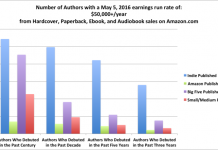
Take a look at Baldur Bjarnason’s “A few random points on DRM” which appears on his blog. It’s in response to the IDPF’s draft EPUB content protection proposal. I report on the proposal here. The whole post is well worth your time. Here’s point 1 out of 11:
DRM works, in some contexts such as software.
One of the advantages of software and apps is that you can apply different forms of copy control for each product or even for each release, catered to the needs of each product.
Big budget games have extremely front-loaded sales (most of it in the first few weeks) and so heavy-handed DRM actually makes economic sense. It doesn’t have to last forever, just over the initial sales bump.
An app can try lesser or greater forms of copy controls in each release and do a detailed analysis of which one is the most cost effective and which is cheaper.
A long-standing title can change the copy controls in the next release if the early one is broken.
Software defines its own behaviour and, as a result, they have much more flexibility in how they apply copy controls.
The problems with applying DRM to ebooks is that they don’t work in the same way as software.
Point 1: Ebooks aren’t software and, as such, can’t use DRM effectively
Ebooks require standardisation of some sort, whether it’s within a single supply channel or across the industry. A publisher cannot experiment with copy controls from title to title because the structure of the industry and the nature of the ebook (it’s a file not an app) means they have to pick a standard DRM method.
The problem is that standardised DRM is ineffective. It has none of the pragmatic advantages of software copy controls, but all of the problems. It can’t adapt to the needs of the title (books with front-loaded sales versus perennials need different kinds of DRM if you are going to go that route).
Which brings us to…


































Baldur makes a lot of sense but he misses the real issue by taking DRM implementers at their word. The real goals of DRM are quite different than stated. Here are two of those real goals:
1) DRM reshapes the market to improve revenue streams. Defeating the secondary (used) book market and defeating the doctrine of first sale (libraries are collateral damage) are key to enjoying revenue throughout the “long tail” of an eBooks life.
2) DRM helps create the feeling that all is right with the world. Evil doers such as pirates are being dealt with and the inconvenience of DRM is as justified as the inconvenience of modern air travel.
Please note that no actual pirates were harmed in the application of DRM.